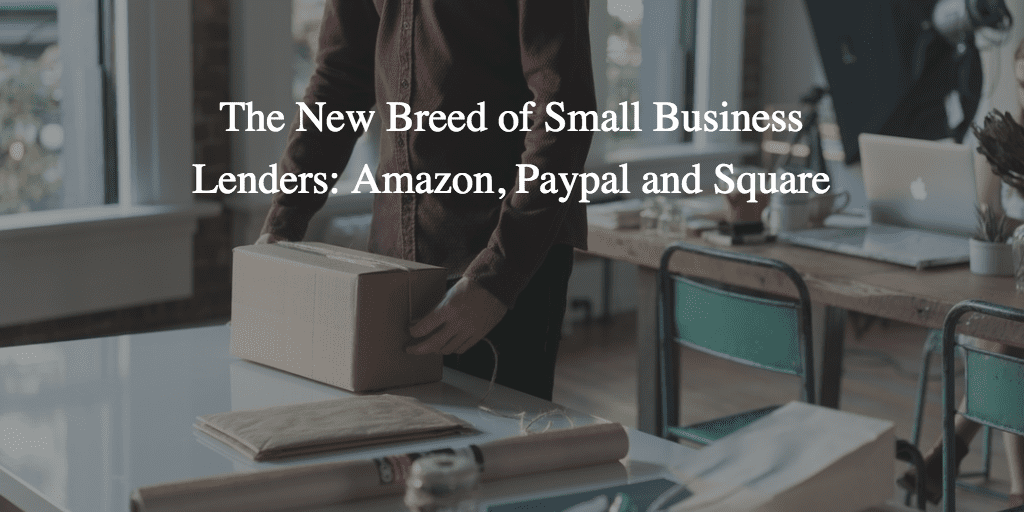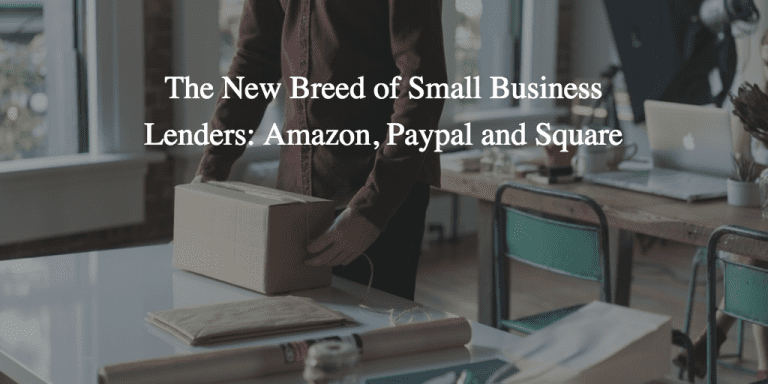
If asked where to get a small business loan most people would state their local banks or even some of the bigger traditional banks. Those aware of the online lending space may mention the likes of Kabbage, OnDeck, Funding Circle or maybe even some of the new online initiatives of big banks like Wells Fargo’s FastFlex product. However there is another, often overlooked segment of small business lenders and they are names you have heard of: Amazon, Paypal and Square.
Until recently I hadn’t paid much attention to these companies. Amazon in particular flies under the radar and little is known about their lending business. Recently it came out that they are doing a considerable amount of lending to small businesses. Amazon lent $1 billion in the last year and has lent $3 billion to more than 20,000 small businesses since launching their lending product in 2011.
Most alternative small business lenders aim to innovate on pricing, speed, transparency or underwriting. Many also claim the use of data for underwriting purposes as a main differentiator. I’d argue that Amazon has more of an advantage when it comes to data since most other lenders rely on third parties or the small business to provide access to their data. Since Amazon is a marketplace for sellers they have an incredible amount of data on the cash flow of businesses that operate on the platform. They also have a significant pool of borrowers, resulting in virtually no customer acquisition costs.
The best way to understand how Amazon lends money to small businesses is hearing about it directly from a borrower. The podcast called Marketplace recently interviewed an Amazon seller and it was fascinating to hear how it works.
The interview highlights Peter Pajitnov, a seller of specialty lightbulbs on Amazon.com. He does about $250,000 a year in sales and a few years ago Amazon asked him if he wanted to borrow money. Pajitnov stated in the interview:
They knew exactly how much I was withdrawing every two weeks through their system, and the amount they offered me was very much based on those volumes.
Not only can Amazon select the borrowers they want to lend to but lending also helps grow the sales on Amazon.com. Pajitnov initially borrowed $1,000 dollars but eventually borrowed $19,000 to buy out a competitor. According to the podcast, the loan application is just a page long and Pajitnov was charged an interest rate between 12 and 14%. One other interesting aspect of Amazon’s lending business is that oftentimes sellers opt to have Amazon fulfill their orders meaning in the case of default there is an opportunity for Amazon to immediately repossess inventory.
Square, like Amazon has a unique advantage when it comes to data and customer acquisition. The road to becoming a more integral part of a small businesses’ financial landscape started with payments. Jackie Reses, who runs Square Capital and the people team at Square spoke in March, 2017 at LendIt USA where she discussed “The Role Lending Can Play in Empowering More Business”. The company has over two million merchants and is able to pre underwrite small businesses with the transaction data they collect.
According to Reses a majority of the 28 million small businesses seek loans less than $500,000 and large institutions don’t bother with loans under $1 million. With transaction data and no customer acquisition cost, Square is able to efficiently underwrite small businesses and have repayment be based on sales. Square’s average loan size is just $6,000. According to Square’s Q1 2017 earnings release Square Capital facilitated over 40,000 business loans totaling $251 million in the first quarter of 2017, up 64% year over year. The company is reportedly looking to lend to consumers as well.
PayPal launched their small business lending operation in 2013. In May, 2017 the company announced it had lent $3 billion to 115,000 businesses across the world. Like Square, the company offered a payment solution for small businesses, but is instead focused solely online. The company aims to be a full service provider, offering numerous solutions to merchants. They recently launched their “Business in a Box” solution where businesses can accept payments with PayPal, build an online store with WooCommerce, manage their finances with Xero and borrow with PayPal Working Capital.
Repayments are based on sales and according to a Forbes article the company recently increased its financing limits to $125,000 or 25% of annual sales. It was previously $97,000 and 18%. Merchants that transact $50,000 through PayPal can be preselected for a $5,000 working capital loan.
Conclusion
While there will continue to be many successful small business lenders it’s important to realize the advantage that companies like Amazon, Square and Paypal have. Many small businesses take the path of least resistance when they need capital and being in any one of these ecosystems is going to provide that seamless and flexible experience. Amazon, Square and Paypal already have traction in small business lending, but I believe we’ll see their lending businesses continue to grow substantially over the coming years.


